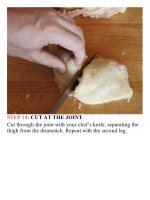The food lab better home cooking through science ( PDFDrive ) 124
Bạn đang xem bản rút gọn của tài liệu. Xem và tải ngay bản đầy đủ của tài liệu tại đây (170.43 KB, 2 trang )
butter is not the ideal medium for searing food—it
simply can’t get hot enough without burning. For
this reason, many chefs makeclarifiedbutter, butter
from which the water and protein have been
removed. It’s the primary cooking fat in India,
where it’s known as ghee. You make it by melting
butter, carefully skimming the white milk proteins
offthetop,andthenpouringoffthegoldenliquidfat,
discarding the watery layer of proteins on the
bottom.Onceclarified,buttercanbeheatedtomuch
highertemperatureswithoutfearofburning.
As I mentioned earlier, clarified butter is used to
make a classic hollandaise, the thinking being that
the water constituent in whole butter will dilute the
sauce.Amucheasierwaytoavoidthiswaterinyour
finishedsauceistojustpourthemeltedbutterslowly
outofthepanuntilallthat’sleftisthewaterylayer
atthebottom,whichyoucanthendiscard.
Totestthetheory,Iheatedupacoupleofsticksofbutter
on the stovetop (the microwave also does just fine) to
200°F,thenslowlydrizzledthebutterintomyeggyolksand
lemon juice, which I had running in the blender (adding a
bit of water to the yolk mixture helps prevent it from
sticking to the walls of the jar). A quick dash of salt and
cayenne pepper, and there it was: perfect hollandaise
without the headache. To make it even more foolproof, I
tried it again using an immersion blender and its jar. I put
theeggyolks,lemon,andwaterinthejar,stuckthewandof
the hand blender down in there, poured in all the melted
butter,andturnedontheblender.Asthevortexdrewbutter
down into the whirling blades, a thick, stable emulsion
formedlikemagic,untilallthebutterwasincorporatedand
my sauce was thick, rich, and light, the way a great
hollandaiseshouldbe.









